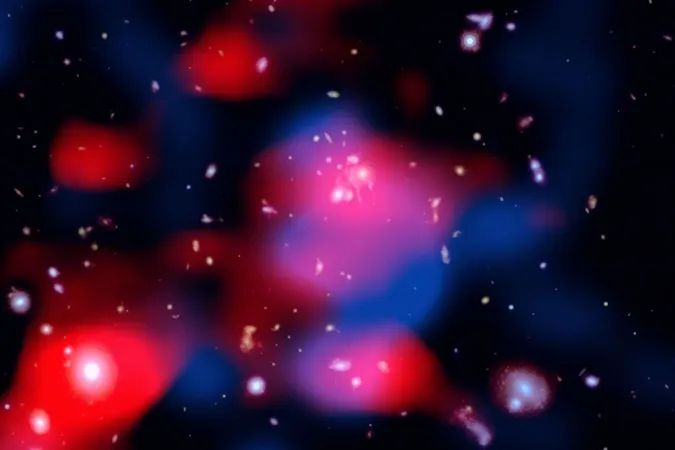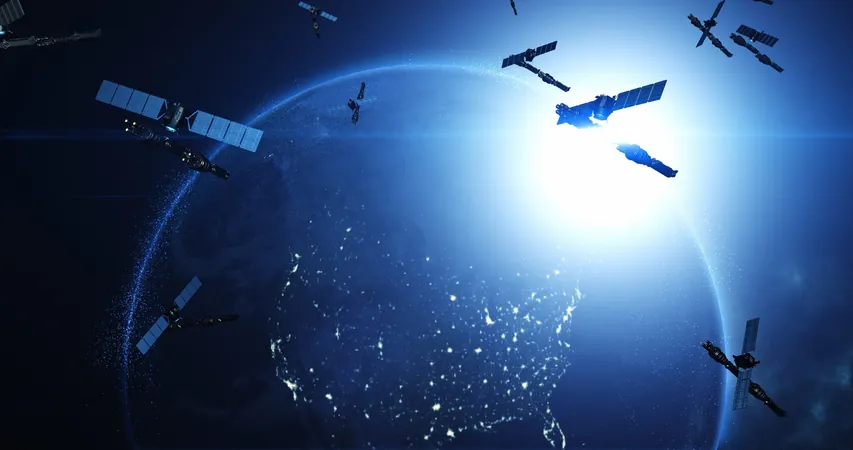
Unveiling the Cosmic Mystery: Massive 'Halo' of Energetic Particles Reveals Secrets of the Early Universe
2025-07-01
Author: Rajesh
In a groundbreaking discovery, astronomers have spotted a colossal halo of high-energy particles encircling a galaxy cluster that formed just four billion years after the Big Bang. This extraordinary find offers a tantalizing glimpse into the conditions that shaped our universe in its infancy.
Dubbed SpARCS104922.6+564032.5, this massive cluster is located an astounding 9.9 billion light-years away. But what has truly captivated scientists is the mystery surrounding its formation—could this glowing halo be the result of explosive supermassive black holes unleashing jets of energy, or is it a product of a cosmic particle accelerator at play?
This newly discovered "radio mini-halo," aptly named despite its colossal size, holds the title of the most distant such structure ever detected. Its radio emissions have traveled a staggering 10 billion years to reach Earth, representing a significant portion of the universe's 13.8 billion-year history.
Utilizing the powerful LOFAR (LOw Frequency ARray) radio instrument in Europe, researchers have shown that galaxy clusters—arguably the largest entities in the universe—are enshrouded in these intricate webs of high-energy particles for the majority of their existence. This critical insight allows scientists to refine their understanding of energy dynamics within these massive structures, enhancing our comprehension of cosmic evolution.
"Finding such a strong radio signal at this distance is truly astonishing," remarked study co-leader Roland Timmerman, an astronomer at Durham University. He emphasized the significance of this discovery, noting that these energetic particles may have been influencing galaxy clusters throughout nearly the entirety of cosmic history.
So, what exactly accounts for this magnificent halo? The research team proposed two intriguing theories. The first suggests that supermassive black holes at the centers of these galaxies might be emitting jets of high-energy particles, which then settle into a vast cloud surrounding the cluster. However, questions arise regarding how these particles preserve their energy across such expansive distances.
Alternatively, the second theory speculates the presence of a natural particle collider surrounding the galactic cluster. Here, particles within the hot ionized gas—or plasma—could be colliding at near-light speeds, creating the high-energy particles observed in the halo.
The researchers believe this discovery provides a rare window into the early stages of a galaxy cluster’s development, challenging previous notions about how long these energetic environments persist. Future studies of this remote radio mini-halo could illuminate the origins of these charged particles, unraveling even more cosmic mysteries.




 Brasil (PT)
Brasil (PT)
 Canada (EN)
Canada (EN)
 Chile (ES)
Chile (ES)
 Česko (CS)
Česko (CS)
 대한민국 (KO)
대한민국 (KO)
 España (ES)
España (ES)
 France (FR)
France (FR)
 Hong Kong (EN)
Hong Kong (EN)
 Italia (IT)
Italia (IT)
 日本 (JA)
日本 (JA)
 Magyarország (HU)
Magyarország (HU)
 Norge (NO)
Norge (NO)
 Polska (PL)
Polska (PL)
 Schweiz (DE)
Schweiz (DE)
 Singapore (EN)
Singapore (EN)
 Sverige (SV)
Sverige (SV)
 Suomi (FI)
Suomi (FI)
 Türkiye (TR)
Türkiye (TR)
 الإمارات العربية المتحدة (AR)
الإمارات العربية المتحدة (AR)